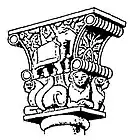Sarnath capital
The Sarnath capital is a pillar capital, sometimes also described as a "stone bracket", discovered in the archaeological excavations at the ancient Buddhist site of Sarnath in 1905.[1] The pillar displays Ionic volutes and palmettes.[2][3] It used to be dated to the 3rd century BCE, during the Mauryan Empire period,[4][1] but is now dated to the 1st century BCE, during the Sunga Empire period.[2]
| Sarnath capital (3rd-1st century BCE) | |
|---|---|
 .jpg.webp) The Sarnath capital front (actual view) and back (reconstructed from available photographs). | |
| Material | Stone |
| Created | 3rd-1st century BCE |
| Present location | Sarnath Museum, India |
 Sarnath | |
One of the faces shows a galloping horse carrying a rider, while the other face shows an elephant and its mahaut.[2]
The capital is suggestive of the Hellenistic Ionic order, and is often discussed in conjunction with the Pataliputra capital.[5][6] The two capitals have also been described as "quasi-Ionic", and compared for example to the anta capitals of the Temple of Apollo in Didyma.[7]
The capital is now located in the Sarnath Museum.[2]
 Reconstruction of the full capital by Percy Brown
Reconstruction of the full capital by Percy Brown Frontal views of the Sarnath capital, in the Sarnath Museum
Frontal views of the Sarnath capital, in the Sarnath Museum
See also
References
- Archaeological Survey Of India Annual Report 1906-7. 1909. p. 72.
- Mani, B. R. (2012). Sarnath : Archaeology, Art and Architecture. Archaeological Survey of India. p. 60.
- Majumdar, B. (1937). Guide to Sarnath. p. 41.
- Presented as a "Mauryan capital, 250 BC" with the addition of recumbent lions at the base, in the page "Types of early capitals" in Brown, Percy (1959). Indian Architecture (Buddhist And Hindu). p. x.
- "Stone brackets or capitals suggestive of the Ionic order" in Allchin, F. R.; Erdosy, George (1995). The Archaeology of Early Historic South Asia: The Emergence of Cities and States. Cambridge University Press. p. 258. ISBN 9780521376952.
- Allchin, F. R.; Erdosy, George (1995). The Archaeology of Early Historic South Asia: The Emergence of Cities and States. Cambridge University Press. p. xi, note of figure 11.30. ISBN 9780521376952.
- Banerjee, Gauranga Nath (1920). Hellenism in ancient India. Calcutta: Butterworth & co. p. 46.